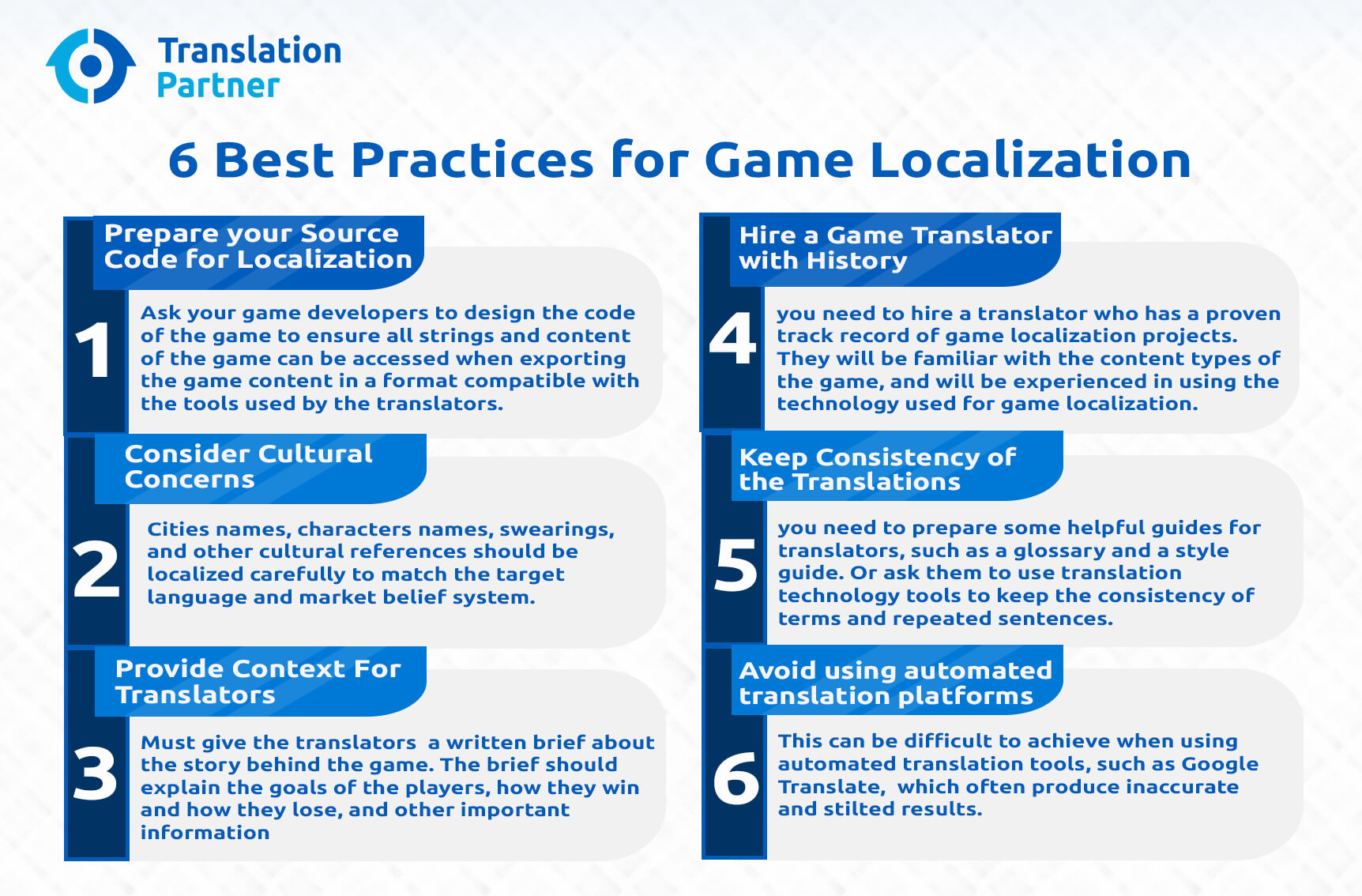the best 6 Practices for Game Localization

I believe you are here because you are starting to localize your game and want to know the best practices for game localization before you start! This is a good way to start your project before it is too late.
Translating your game into different languages will help you reach players from different parts of the world to know your game and company. Hence, your sales will boom and your company will grow.
I will list a few practices that I think will be very helpful for you.
Number 1: Prepare your Source Code for Localization
This one is really important before your start and can help you save time down the road. Ask your game developers to design the code of the game to ensure all strings and content of the game can be accessed when exporting the game content in a format compatible with the game localization tools used by the translators.
Ask them to avoid hard-coding any parts of the game content to be translated. If this is not considered, you will see untranslated strings and sentences when you import the translation back to the game. This can cause delays in other phases of the game localization project,
Number 2: Consider Cultural Concerns
The localized game will be played by people from different regions of the world. These regions will have their religions, belief systems, and traditions.
From a marketing perspective, you don’t need your customers to have a bad experience or receive negative communication while they are playing the game.
To avoid these pitfalls, make sure the game localization team considers any cultural references appearing in the game during the localization process.
Salutations, city names, characters’ names, swearings, and other cultural references should be localized carefully to match the target language and market belief system.
Request A FREE Translation Cost Estimate!
Click the below button and request a free price quote for translation services—no commitment on your side.
Number 3: Provide Context For Translators
If you want to help someone understand a story, it is better to draw some pictures to visualize the actions and give context to the environment. The same applies to a translator while working on a game localization project.
You need to give them some context to understand how the game players move and react and what their environment looks like.
The best context can be a game version to be played by translators to understand how it works. Another way is to give them a written brief about the story behind the game. The brief should explain the goals of the players, how they win and how they lose, and other important information.
The more context you give, the more accurate the translation becomes.
A Concept: What is localization?
Localization is the process of adapting a product or service to a particular market or locality. This can involve tailoring the content, look and feel, functionality, pricing, and even the delivery model to meet the needs and preferences of target customers in that location.
It’s important to note that localization is not simply translation – although translation may be required as part of the localization process. Localization takes into account the language, culture, and nuances of a specific market, ensuring that the adapted product or service is relevant and appealing to target customers in that region.
Number 4: Hire a Game Translator with a History
Game localization texts have their unique nature and require a certain level of experience to provide an excellent translation. The game content entails different types of texts. The UI text requires terms similar to the software localization ones, while the characters’ dialogue needs professional literary translation.
At the same time, the game marketing materials, such as press releases and brochures, should be translated by a professional translator who works with marketing material.
For all of this, you need to hire a translator who has a proven track record of game localization projects. They will be familiar with the content types of the game and will be experienced in using the technology used for game localization.
If you are not sure where to find such a translator, you can simply hire a game localization services agency that has a pool of vetted translators.
Number 5: Keep Consistency of the Translations
Translating a game is not a one-off project. It is a continuous project with frequent updates. Also, you may need to work with a large number of translators to finalize the language localization phase on time.
What happens if one sentence or a term is repeated in the game and is translated differently every time it is mentioned? Or what if a character’s name is translated with different spelling in different parts of the game? This all means a bad experience for the players.
To avoid this, you need to prepare some helpful guides for translators, such as a glossary and a style guide. Or ask them to use translation technology tools to keep the consistency of terms and repeated sentences.
A glossary will contain the approved terms to be used consistently across the game content, while a style guide will help you unify the language tone used in translation. For sentences, the translation technology tools can help to find out any inconsistent sentences and fix that.
A question: what are UI localization best practices is localization?
UI localization best practices include taking cultural differences into account, ensuring that text is properly translated and localized, and testing translations on a variety of devices.
Text translation and localization can be difficult because it’s not always possible to capture the exact meaning of a word or phrase in another language. It’s also important to ensure that translations are correctly formatted for the target language, taking into account things like sentence structure, punctuation, and tone.
Testing translations on a variety of devices is important because screen sizes and resolutions can vary from one device to the next. Translation errors that only occur on certain devices can be missed if they’re not tested on all types of devices.
Number 6: Avoid using automated translation platforms
When it comes to localization, game developers face a unique challenge. Not only do they need to ensure that their game is accessible to players in different regions, but they also need to maintain the game’s original tone and style.
This can be difficult to achieve when using automated translation tools, such as Google Translate, which often produce inaccurate and stilted results. In addition, automated translation can often miss important cultural references and idiomatic expressions.
As a result, it is often best for game developers to rely on professional translators who are familiar with both the source material and the target audience. By working with experienced localization experts, developers can be confident that their games will be accurately and appropriately translated for players in all regions.

Conclusion
These are some of the best practices for game localization. Keeping them in mind will help you finalize the project easily and quickly.
Having a source code written well can save you time in the future while hiring a specialized translator will mean high-quality translations.
Make use of guides and tools to keep the consistency of terms, writing style, and repeated sentence translations.
Never disregard cultural considerations while working on a game localization project, as this may harm your game’s reputation.
